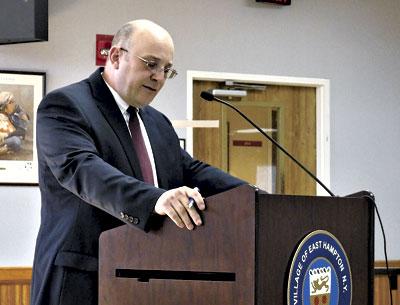Antennas Headed for Approval

It took five sessions and as many months, but John Huber, an attorney representing P.C. Schenck and Sons, a fuel company at 60 Newtown Lane, got the closure he sought on Friday when the East Hampton Village Zoning Board of Appeals decided the firm’s application for 12 AT&T antennas and related equipment had been thoroughly vetted. The hearing was closed, and a favorable decision is expected at the board’s next meeting, May 9.
AT&T wants to mount 12 antennas on the side of Schenck’s 180,000-gallon, 44-foot-tall oil tank and to install six equipment cabinets on a concrete pad at ground level. Neighbors, including residents of Barns Lane and a representative of the shops and offices at 66 Newtown Lane, had brought multiple concerns to the board, including noise from the equipment cabinets and potential health hazards from radio frequency emissions. One neighbor had warned that welding the antennas to the tank, which has just one wall, could have catastrophic results.
As the hearing proceeded at different meetings, the board asked that the noise be mitigated and asked that a 20-foot landscaped buffer be provided between the facility and adjacent property lines.
Mr. Huber had told the board at a previous meeting that a 12-foot-high structure would cut down on noise by shielding the cabinets and reducing the decibel level to less than ambient noise. The applicant also agreed to reduce the size of the concrete pad from 21-by-32 to 12-by-32 feet so that no part of it would fall within the 30-foot yard setback.
The board seemed ready to close the hearing March 28 when Kevin Seaman, an attorney for the East Hampton School Board, said it was concerned about the safety of students at the adjacent East Hampton Middle School, suggesting that “disturbing emissions of electrical discharges” had not been addressed. He also said the school board wanted to challenge the AT&T assertion that the antennas were necessary for cellphone coverage. But on Friday, Frank Newbold, the zoning board chairman, said the school board would not raise anything more.
At one point, Mr. Newbold summarized the application, noting that the Federal Communications Commission does not allow an application to be denied on the grounds of radio frequency emissions if they are within the agency’s allowable limit. The village’s engineer, Drew Bennett, verified that the emissions would be within 5 percent of that limit. He also has said that welding the antennas to the fuel tank would not be dangerous if the work followed specific protocol.
One other voice was added to the discussion on Friday, however. Senie Bartoli, who lives on the adjacent Barns Lane, said she had only recently learned of the proposal. She went into detail about having to remove part of a bluestone patio when she bought the house almost nine years ago in order to obtain a certificate of occupancy.
“It’s sort of curious that I was told that it would be impossible for me to get a variance, even though my bluestone in my backyard was not interrupting anybody’s privacy or lifestyle,” Ms. Bartoli said. “I thought to myself, ‘How can that be when they pick on somebody like me, yet AT&T can come in and put in several big cellphone towers, and that variance seems to be okay?’ ”
Ms. Bartoli spoke warmly of her neighbors and asked if alternatives had been explored, such as a distributed antenna system, in which multiple antennas are connected to a common source.
After Mr. Newbold noted that Barns Lane borders commercial property and that Schenck was “an established neighbor,” Mr. Huber answered her question about a distributed antenna system. He said it was not appropriate in this case and called the proposed antennas “a fair compromise between a new 120-foot, freestanding cell tower” and a distributed antenna system. “What we’re proposing is relatively low, there’s virtually no adverse visual impact, but at the same time it provides enough coverage so that this area can enjoy reliable wireless service. We’ve purged this application of any aspect that has an impact on the community,” he said.
